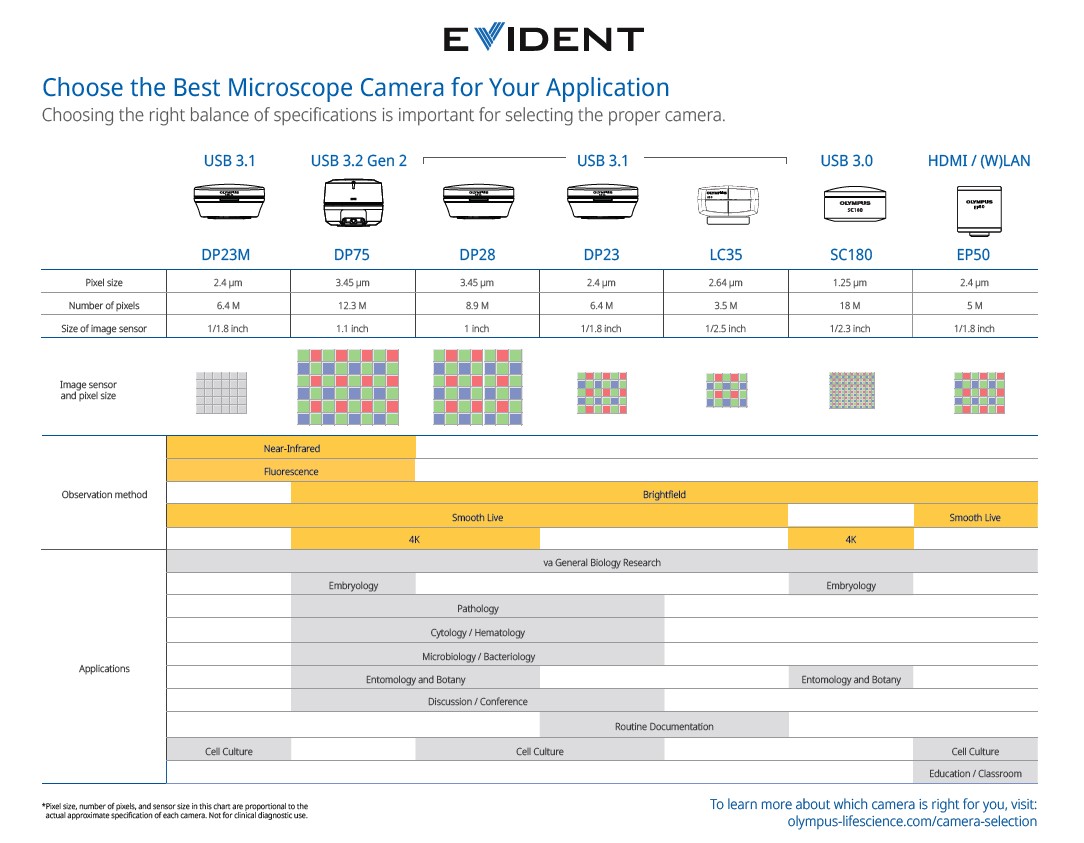컬러 디지털카메라
과학 현미경 카메라로 생명과학 분야에서 비전을 확장하십시오.Olympus 제품군은 다양한 용도와 예산에 맞는 다양한 디지털 현미경 컬러 카메라를 공급합니다.필요에 맞는 적절한 카메라를 선택할 때는 사양의 적절한 균형을 유지하는 것이 중요합니다. Olympus의 광범위한 제품군은 일반 생물학 연구 및 교육에서 병리학, 세포 배양, 발생학 및 신약 개발에 이르기까지 활용 분야가 방대합니다.당사의 현미경 카메라는 다양한 이미지 센서와 픽셀 크기를 제공하며, 관찰 방법은 형광, 명시야 및 적외선 등입니다. Olympus는 이미지가 중요하다는 것을 알고 있으며, 디지털 현미경 카메라를 통해 최첨단 광학, 뛰어난 디테일 및 빠른 실시간 이미지화를 통해 세부 사항을 확인하고 작업 품질을 향상할 수 있도록 지원합니다. | 관련 영상 |
|---|
디지털 현미경 컬러 카메라
Maximum Compare Limit of 5 Items
Please adjust your selection to be no more than 5 items to compare at once
디지털 현미경 카메라에 대해 자주 묻는 질문
디지털 이미징이란 무엇입니까?
디지털 이미징은 이미지의 전자적 기록을 설명하는 데 사용되는 일반 용어입니다.일몰 장면부터 현미경 표본 및 스캔한 문서에 이르기까지 거의 모든 것을 디지털 방식으로 캡처할 수 있습니다.
디지털 이미지란 무엇입니까?
디지털 이미지는 일련의 픽셀 또는 그림 요소로 구성됩니다.컴퓨터는 이미지 파일을 읽고 픽셀을 표시하여 모니터에 이미지를 형성합니다.
디지털 이미징의 장점은 무엇입니까?
현미경 검사용 디지털 이미징에는 네 가지 핵심적인 이점이 있습니다.
- 영구 기록: 이미지 품질 저하 없이 동일한 디지털 이미지를 무한대로 복제할 수 있습니다.결과적으로 디지털 이미징은 연구 슬라이드를 보존하고 샘플의 품질 저하 문제를 방지하는 데 도움이 됩니다.
- 이미지 공유: 디지털 이미지는 멀리 떨어져 있는 동료에게 전자적으로 보낼 수 있으므로 협업 프로젝트를 위해 슬라이드를 우편으로 보내는 배송비를 절약할 수 있습니다.
- 이미지 조정: 현미경용 cellSens 이미징 소프트웨어와 같은 편집 프로그램을 사용하면 단 몇 번의 클릭만으로 디지털 이미지를 쉽게 수정하여 대비 불량 및 과도한 노이즈와 같은 문제를 해결할 수 있습니다.
- 정량적 분석: 디지털 이미징은 새로운 통찰을 얻는 데 도움이 되는 정량적 이미지 분석을 위한 데이터를 제공합니다.예를 들어, 데이터 포인트를 데이터베이스에 들어 있는 이전의 이미징 결과와 비교할 수 있습니다.
현미경의 디지털 이미징 품질은 어떻게 향상할 수 있을까요?
현미경 이미지의 품질을 향상하려면 용도에 맞는 기능을 갖춘 적절한 광학 장치와 카메라를 선택하십시오.
실험을 위한 현미경 대물렌즈와 카메라를 찾는 데 도움이 되는 온라인 자료가 있습니다.Olympus 블로그를 먼저 살펴보시면 좋습니다.다음 블로그 게시물을 참고해 보십시오. 적절한 현미경 대물렌즈를 선택하는 방법: 적절한 현미경 카메라를 선택하기 위한 10가지 질문과 4가지 도구
어떤 디지털 현미경 카메라 기능이 가장 중요할까요?
수많은 요소가 이미지 품질에 기여합니다.일반적으로 가장 중요한 것은 카메라 해상도와 감도입니다.감도는 카메라 센서가 샘플의 빛을 얼마나 잘 감지하는지 나타냅니다.해상도는 카메라가 캡처할 수 있는 정밀함의 양입니다.그러나 앞서 언급한 것처럼 이런 기능이 광학, 시스템 및 용도에 적합해야 합니다.
다음의 예를 생각해 보십시오. 고해상도 카메라는 손실된 샘플의 구조 정보를 광학 기술을 통해 복구할 수 없기 때문에 NA가 낮은 대물렌즈와는 맞지 않습니다.그 이유는 빛이 카메라의 픽셀 피치보다 넓게 퍼지기 때문입니다.이런 경우에는 저해상도 카메라가 NA가 낮은 대물렌즈와 잘 맞습니다.
또는 700~900파장(nm) 범위에서 관찰해야 하는 경우를 가정해 보겠습니다.이런 긴 파장을 감지할 수 있는 카메라를 선택하는 것이 중요합니다.
고려해야 할 다른 많은 요소가 있으므로 백서 현미경 카메라를 선택할 때 고려해야 할 사항을 읽어 보십시오.
어떤 유형의 현미경 카메라 센서를 선택해야 할까요?
여러 유형의 센서가 있으며, 각기 장단점이 있습니다.
- CCD는 Charge-Coupled Device(전하 결합 소자)의 약자입니다.간단히 말해서 CCD는 디지털 카메라에서 센서로 사용되는 감광 영역이 있는 반도체 칩입니다.CCD 센서는 빛을 포착하고 그것을 전하로 변환하여 이미지를 형성하는 디지털 픽셀 데이터를 제공합니다.역사적으로 CCD 센서는 과학적 활용을 위한 최선의 선택이었습니다.그러나 새로운 센서 기술이 등장함에 따라 이 오래된 기술을 사용하는 빈도는 서서히 줄어들고 있습니다.
- EMCCD는 Electron Multiplying Charge-Coupled device(전자 증폭 전하 결합 소자)를 나타냅니다.EMCCD는 CCD 읽기 노이즈 위의 저조도 신호를 증폭하는 일종의 CCD 센서입니다.기존 CCD에서는
매우 낮은 신호 수준이 일반적으로 센서의 읽기 노이즈 아래로 떨어지므로 매우 낮은 조도에서 빠른 프레임 속도로 캡처가 필요한 용도에서 이미징
기능이 제한됩니다.
EMCCD 카메라는 약한 빛을 감지하는 능력이 뛰어나므로 저조도 카메라라고도 합니다.감도가 높기 때문에 매우 낮은 조도에서 빠른 생물학적 현상을 포착하는 데 유용한 도구입니다. - CMOS는 Complementary Metal-Oxide Semiconductor(상보성 금속 산화물 반도체)의 약자로 CCD 기술의 후속 제품입니다.CMOS와 CCD의 가장 중요한 첫 번째 차이점은 신호 전자의 판독
구조입니다.
개별 광 감지 다이오드용 다중 판독 증폭기 덕분에 CMOS는 CCD보다 판독 속도가 훨씬 빠릅니다.빠른 판독의 단점은 롤링 셔터 왜곡입니다.CMOS는 모든 픽셀을 동시에 캡처하는 대신 이미지 전체를 빠르게 스캔하여 데이터를 수집하기 때문에 노출 시간 차이로 인해 때때로 왜곡이 발생할 수 있습니다.
반면에 CCD 센서는 전하를 저장하는 동안 들어오는 광자를 수집하여 모든 픽셀을 동시에 판독할 수 있도록 하여 이런 왜곡을 방지할 수 있습니다.
CMOS는 역사적으로 CCD에 비해 낮은 신호 대 잡음비를 제공했지만 오늘날에는 많은 고품질 CMOS 카메라를 찾을 수 있습니다.또한 글로벌 셔터 CMOS를 도입하여 롤링 셔터로 인한 왜곡을 극복했습니다. - sCMOS는 Scientific Complementary Metal-Oxide Semiconductor(과학용 상보성 금속 산화물 반도체)의 약자로, 보통 과학용 CMOS로 축약됩니다. sCMOS는 큰 픽셀 크기와 조용한 노이즈 성능을 갖춘
일종의 CMOS 센서입니다.이 센서는 기존 CMOS보다 감도가 더 높습니다. sCMOS 센서는 보통 냉각하여 암전류를 최소화함으로써 냉각된 CCD 센서와 유사한 높은 신호
대 잡음비를 달성합니다.
sCMOS와 EMCCD 카메라의 가장 중요한 차이점은 sCMOS 카메라에는 장노출 기능이 없다는 것입니다.EMCCD 카메라는 형광 신호가 약한 장노출 또는 생물발광 이미징 용도에 선호되는 반면, sCMOS 카메라는 일반적으로 다양한 이미징 기술로 작업할 수 있는 기능으로 알려져 있습니다.
가장 적합한 디지털 카메라는 최종적으로 구체적인 용도에 따라 다르므로 궁금한 점이 있으면 언제든지 문의해 주십시오.
디지털 현미경 컬러 카메라 자료
현미경 카메라를 선택할 때 고려해야 할 사항관찰 및 실험을 위한 고품질 이미지를 얻기 위해 현미경 카메라에서 사용되는 최신 방법과 기술을 요약했습니다. | 인포그래픽 |
|---|
Not Available in Your Country
Sorry, this page is not
available in your country.
